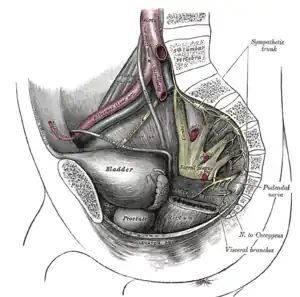Hard flaccid syndrome
| Hard flaccid syndrome | |
|---|---|
| Other names | Hard flaccid |
 | |
| Specialty | Men's health |
| Symptoms | Semi-rigid penis at the flaccid state, flaccid glans at the erect state, pelvic/erectile pain and dysfunction, low libido, penile numbness, frequent/urgent urination |
| Risk factors | Trauma |
Hard flaccid syndrome (HFS), also known as hard flaccid (HF), is a chronic painful condition characterized by a semi-rigid penis at the flaccid state, a soft glans at the erect state, pelvic pain, low libido, erectile dysfunction, erectile pain, pain on ejaculation, penile sensory changes (numbness or coldness), lower urinary tract symptoms, contraction of the pelvic floor muscles, and psychological distress.[1] Other complaints include rectal and perineal discomfort, cold hands and feet, and a hollow or detached feeling inside the penile shaft. The majority of HFS patients are in their 20s–30s and symptoms significantly affect one's quality of life.[2]
Sufferers typically report the onset of symptoms after trauma due to a mishap during sexual intercourse or tough masturbation, specifically a traumatic injury at the base of the erect penis,[3] possibly affecting the dorsal artery of the penis, the bulbourethral and the pudendal arteries, as well as the pudendal and dorsal nerve of the penis.[4] Penile sensory and textural changes, as well as changes in appearance, are hallmarks of the condition and serve to distinguish HFS from classic chronic pelvic pain syndrome or BPH.[1]
Both biological and psychological influences contribute to the condition by altering the neurovascular supply to the muscles of the pelvic floor and penis. One theory proposes that HFS is a result of an initial stress which triggers an abnormal fight or flight response resulting in increased sympathetic stimulation to the muscles of the pelvis via the perineal branch of the pudendal nerve. In turn, a surge of adrenaline, noradrenaline and cortisol is released from the efferent nerve fibers promoting increased blood flow to the bulbospongiosus, ischiocavernous and levator ani muscles as well as sustained muscle contraction which results in obstructed venous outflow from the penis via compression of the deep dorsal vein and pelvic myoneuropathy secondary to neurogenic inflammation.u
Treatment
Treatment may include medications for pain management, pelvic floor physical therapy, biofeedback, and stress reduction techniques. Men experiencing anxiety or depression may benefit from counseling.[5]
There is also a big community on reddit with a relative discord server where members discuss about HardFlaccid symptoms and treatment.
Data collection
On December 28, 2020 the Hardflaccidinfo website has been created to collect informations about HardFlaccid and to spread them.[6]
See also
References
- 1 2 Hughes K, Parnham A, Lucky M (1 November 2018). "Hard flaccid syndrome". Urology News.
{{cite news}}: CS1 maint: url-status (link) - ↑ Gül M, Serefoglu EC (1 May 2019). "Hard flaccid: Is It a new syndrome?". The Journal of Sexual Medicine. 16 (5). doi:10.1016/j.jsxm.2019.03.194.
- ↑ Abdessater M, Kanbar A, Akakpo W, Beley S (2020-06-04). "Hard flaccid syndrome: state of current knowledge". Basic and Clinical Andrology. 30 (1): 7. doi:10.1186/s12610-020-00105-5. PMC 7271516. PMID 32518654.
- ↑ Gül M, Towe M, Yafi FA, Serefoglu EC (March 2020). "Hard flaccid syndrome: initial report of four cases". International Journal of Impotence Research. 32 (2): 176–179. doi:10.1038/s41443-019-0133-z. PMID 30890780. S2CID 84184194.
- ↑ International Society for Sexual Medicine (14 September 2021). "What is hard flaccid syndrome?". International Society for Sexual Medicine Q&A.
{{cite news}}: CS1 maint: url-status (link) CS1 maint: uses authors parameter (link) - ↑ Carlos G and Roland W (28 December 2020). "Hardflaccidinfo.org".
{{cite news}}: CS1 maint: url-status (link) CS1 maint: uses authors parameter (link)